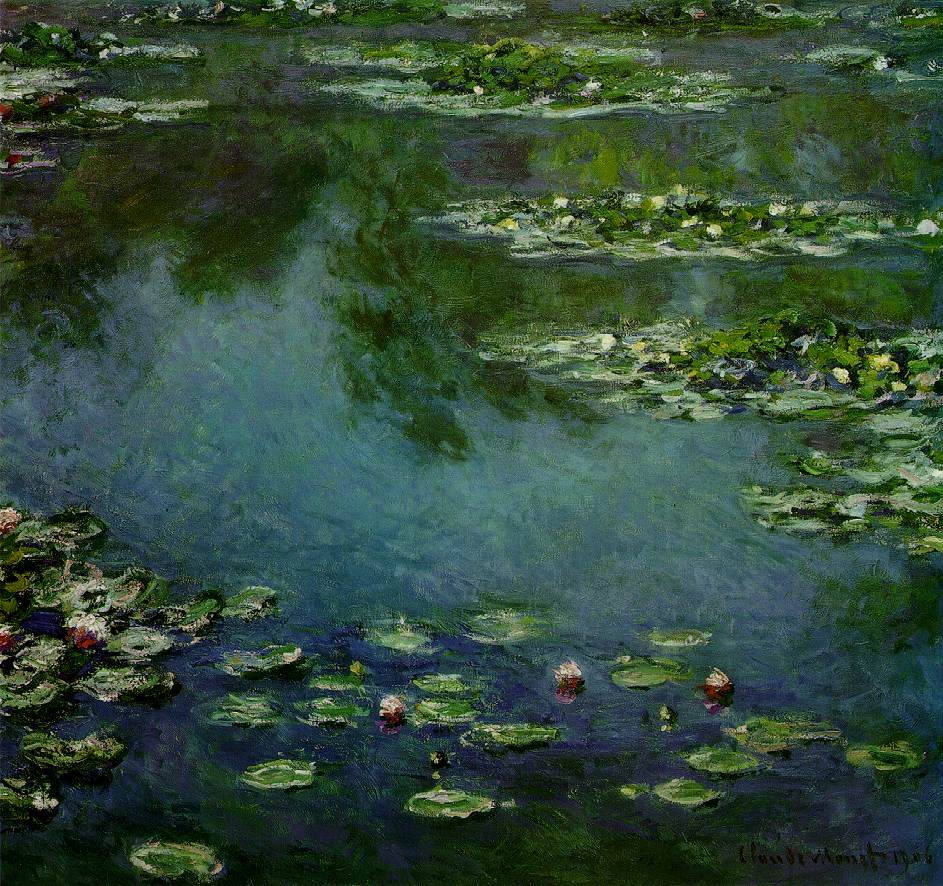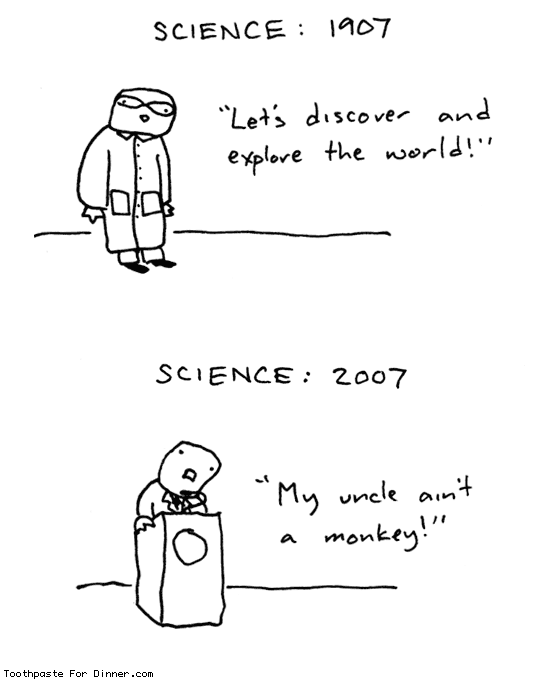Sasha informed me today that I actually posted about something before Boing Boing!
About what you ask? The science tattoo flickr set [Update: now website] that I wrote about back in October.
Take that Boing Boing, I scooped you by two whole months.
Here are some other interesting science tattoos that didn't make my first entry:


An archaeopteryx, the first evolutionary tree sketched by Darwin, and a tardigrade.
20 December 2007
Science tattoos, part II
Posted by
Amy
at
10:50 PM
0
comments
![]()
Labels: Art
19 December 2007
It's a Big Big World
 I am home for the holidays, and am watching TV at different hours than usual. Lucky for me, I caught an episode of "It's a Big Big World" on PBS. This show features adorable puppet animals that live in and around a tree and get kids to think about science and the world around them. From the PBS website:
I am home for the holidays, and am watching TV at different hours than usual. Lucky for me, I caught an episode of "It's a Big Big World" on PBS. This show features adorable puppet animals that live in and around a tree and get kids to think about science and the world around them. From the PBS website:
"As they accompany Snook and his pals on adventures and investigations in the World Tree, kids will experience science, not as just a collection of facts, but as an exciting process of discovery. Viewers will see characters who are excited about science, who look for answers to the scientific puzzles they encounter, and who follow the steps and methods of scientific investigation. Through the stories of individual characters, kids will learn about different animals - how they live, grow, and change. The series will also introduce children to geography, providing them with a basic understanding that the world is bigger than their immediate surroundings and a sense that they are an important part of a larger community."
The episode I watched had a variety of science topics - they talked about sap (and how if kids had eaten syrup on pancakes they had eaten tree sap) and how the various animals ate in different ways. One of the characters is an old turtle, and they mentioned that turtles have been around for a really long time, before even dinosaurs.
I was impressed. Good job PBS, I'll watch again.
Posted by
Amy
at
9:47 PM
0
comments
![]()
11 December 2007
Coelacanths are everywhere
...and that's a good thing. So, I was going to write a blog entry all about the coelacanth-based Pokémon, Relicanth. But when researching the coelacanth, I realized they show up a lot of places in the media (or at least in cartoon form).
So, I was going to write a blog entry all about the coelacanth-based Pokémon, Relicanth. But when researching the coelacanth, I realized they show up a lot of places in the media (or at least in cartoon form).
Coelacanths first appear in the fossil record about 410 million years ago, however no fossils of coelacanth species were found after the end of the Cretaceous period (about 65 million years ago). So, scientists thought the coelacanth was extinct. That was until 1938 when the coelacanth was first rediscovered in a fishing haul off the coast of Africa (and is now often called a living fossil). Unknown to me, until I started writing this entry, there are actually two species of coelacanth, Latimeria chalumnae found along the western edge of the Indian ocean and L. menadoensis which live in Indonesia (the species was only named in 1999).
Keep reading for more instances of cartoon coelacanths... I've covered Pokémon, but a similar game Digimon also has a coelacanth-monster, Coelamon. Coelamon has attacks called fossil bite and ancient bite.
I've covered Pokémon, but a similar game Digimon also has a coelacanth-monster, Coelamon. Coelamon has attacks called fossil bite and ancient bite.
There are several video games that feature coelacaths. One of which is Nintendo's Animal Crossing which allows you to catch them while fishing (Dinofish.com has a video of this you can watch here). Dinofish also has an extensive list of other coelacanth sightings in the media (under the conservation tab) as does the wikipedia article if you feel like exploring further.
Thus concludes our tour of pop culture coelacanth sightings. I hope you had fun.
Posted by
Amy
at
11:38 AM
1 comments
![]()
10 December 2007
Bio-Christmas Carol
Well, this is two blog entries in a row about the Science Creative Quarterly, but I promise something different next time.
To get you in the proper holiday mood, Vince LiCata submitted a great Bio-Christmas Carol featuring Dr. Scrooge and his graduate student Bob Cratchett. Not forgetting of course the spirits who visit Dr. Scrooge: Past (a Developmental Biologist), Present (a Biochemist), and Future (an Evolutionary Biologist).
Now if only we could get this version turned into a movie starring some Muppets.
Posted by
Amy
at
9:45 PM
0
comments
![]()
Labels: holidays
07 December 2007
Haiku Phylogeny
I like it when people are encouraged to be creative with science - which is the aim over at The Science Creative Quarterly. It looks like they are trying to set up a phylogeny of life based on haiku poems. So, pick your favorite organisms and start writing haiku (3 lines with 5, then 7, then 5 syllables). Then of course submit them to SCQ and feel free to leave them here too via comments. I picked 2 members of the water lily family (which are early diverging flowering plants) as my inspiration.
I picked 2 members of the water lily family (which are early diverging flowering plants) as my inspiration.
WATERLILIES
floating on water
Nymphaea blooms in splendid
color. Monet paints. VICTORIA
VICTORIA
children sit upon,
water gardens cultivate,
massive floating leaves.
Posted by
Amy
at
12:15 PM
0
comments
![]()
Labels: aquatic plants, plants, poems
06 December 2007
Silverfish
While decking your halls, why not sing biology inspired carols such as O Chromosomes and this song I found over on Ugly Overload, about silverfish.
Silver Fish
(to the tune of Silver Bells)
City cellars
Moldy cellars
We have just ventured down
To the basement to get things for Christmas
Lots of boxes, stacks of boxes
I think this one's the tree
As we move them we're likely to see...
Silver fish, Silver fish
Its Christmas time in the cellar
Centipedes, race with ease
Soon it will be Christmas Day
Strings of webbing
Spider webbing
We're disturbing their lairs
As we track down our holiday treasures
Its disgusting
These need dusting
'fore we take them upstairs
And along for the ride there will be
Silver fish, Silver fish
Its Christmas time in the cellar
Centipedes, race with ease
Soon it will be Christmas Day
The song is correct, silver fish most often feed on polysaccharides (aka complex sugars like cellulose and starch) including book bindings, glue, hair, and paper. The wikipedia article points out that
"The damage caused by silverfish is negligible and they have no direct effect on human health beyond psychological distress to those who are frightened or disgusted by their appearance."Here, here, they sort of give me the heeby jeebies too.
Posted by
Amy
at
12:37 PM
0
comments
![]()
05 December 2007
All I Need are Microcosmos
I've been playing the new Radiohead album In Rainbows obsessively since October. So, when I saw this video (first over at Bug Girl's Blog) that takes the song "All I Need" and adds some beautiful video clips from the film Microcosmos I had to post it here. I also have to watch that movie.
Posted by
Amy
at
3:53 PM
0
comments
![]()
04 December 2007
Finch comic
Comic from Animals Have Problems Too:
The Galapagos finches (also called Darwin's finches) of course being the birds that helped Darwin formulate his theory of evolution by natural selection (although he didn't realize their significance until back in England with the help of an ornithologist). They are still under study by many, but notably Peter and Rosemary Grant which have shown beak size can rapidly change via natural selection in response to climatic changes.
Posted by
Amy
at
10:03 PM
1 comments
![]()
03 December 2007
Snowflakes
It is snowing outside my window, so I thought I'd share this site I first read about over on the Guild of Scientific Troubadours, even if it's not exactly biology.
The USDA Beltsville Agricultural Research Center has an Electron Microscopy Unit where they can create SEM images of snowflakes.
That last sentence was a mouthful, but in short, they can see the actual 3D structure of common snow formations, and they are stunning:
I also learned that there are snow classification guidelines, and what I think of as the classic snowflake (pictured above) is a "hexagonal plate with dendritic extensions".
Each snowflake might be unique, but we can classify them. There is even a field guide!
Posted by
Amy
at
1:58 PM
0
comments
![]()
01 December 2007
Giant microbes
Need stocking stuffers or a gift for that hard-to-buy-for scientist? Then I direct you over to Giant Microbes - a site that sells plush versions of microbes.
I bought these for all my family members two years ago and even non-biologists like them. When people asked my sister what she got for Christmas that year, she proudly exclaimed "Syphilis!".



(Syphilis, T4 bacteriophage, Penicillin, and E. coli)
Posted by
Amy
at
6:08 PM
0
comments
![]()




